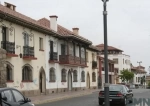Historic Center of La Serena. La Serena - CHILE
Direccion:
La Serena The city of La Serena was founded by Don Juan de Bohon in the year 1544. In the year 1548 is destroyed by the Indians, and on August 26 1549, was refounded by Francisco de Aguirre with the name of San Bartolomé de la Serena. Its layout was a primitive grid 6 x 6 blocks of Spanish, which now corresponds to the streets and Videla Almagro for the North, the South Alameda, PP Muñoz for the West and the streets and Zorrilla Vicuña in the East.
In colonial times, the city was exposed to the assault of pirates and privateers, and in 1680 and was sacked and burned by Bartholomew Sharp. The colonial architecture that characterized La Serena is the mud and straw, with Corralón, gate house and the interior, having a religious architecture also made mostly of stone masonry. This style dominated until the 1840s, when the city begins to transform into one of the better conformity of the country thanks to the mining boom that brought the exploitation of copper from the hills of Tamaya, among others, an activity in which the employer José Tomás Urmeneta.
During the second half of the nineteenth century, attracted both by the mining trade, reaching a significant number of migrants, which included English and American carpenters, who printed a particular stamp to the city with its buildings. It is possible to distinguish a classical period between 1830 and 1860, formally linked to the American Classic Revival and later, between 1850 and 1880, a classic serenense characterized by the establishment of foreign carpenters and the formation of other regional and enrich those complex carpentry decorativa, widespread use antetecho the pilaster on the front and the tejuela larch. After 1880 the architecture of La Serena left orders to enter a pure eclectic period (1880-1940).
By 1940 it was incorporated into the city and the neo-colonial style. Relate to this style buildings, the City Courts, the Central Bank, the Railway Station and the Archbishop s Palace. Some of these buildings were built within the "Plan Serena", promoted by the government of Gabriel González Videla (1946-1952), which was a center of high homogeneity and character.






